I am sick.
It’s not been a pleasant week.
You should understand: I HATE getting a cold. I’m sure no one enjoys it, but I DESPISE it. I take it personally, as an attack on my body from a foreign enemy. So I’ve been fighting it. Vicodin-assisted slumber ensures a full night of rest to purge the invader from my shores. Massive vitamin intakes guarantee that I’m running at maximum capacity of necessary nutrients. The irrigation attack relies on constant ingestion of water throughout the day, flooding the system and washing away the evil.
So far, the bastard has still managed to survive. So we’re upping the defcon. It’s time.
Scorched Earth.
The Scorched Earth policy is a last-ditch effort. The nuclear option. Salting the soil so that nothing may grow. Total devastation.
Alcohol.
Normally, when sick I try to avoid alcohol, as even I can admit it never seems to help the healing process. However, with enough quantity for a sudden and all-encompassing attack, it can be quite effective. Last year I was in a vigorous training program leading up to my tae kwon do black belt test, chiefly consisting of more push-ups, crunches, and jumping-jacks than I thought possible. The test was a 3.5 hour marathon of cardio, techniques, cardio, forms, cardio, sparring and cardio. Brutal. Although high from the rush immediately following the test, when I returned home and settled, my body came crashing down. Hard. The cold that had been lurking in the wings, waiting for a moment to strike hit me while I was down, and I spent the next week feeling downright miserable. The following Saturday was our belt ceremony, and those of us who had passed joined up in Boston that evening for some un-taekwondo-like activities, principally at a bar where a fellow classmate worked. Multiple shots, beers, and mixed drinks followed, and it was truly a celebration. When I got home, I promptly passed out on my couch until about 5am, then groggily stumbled to bed for another 9 hours. When I awoke, the cold I had been rallying against had vanished. I had so poisoned every ounce of my body that the virus had fled. Scorch the Earth so that nothing may grow. I love the smell of Jack Daniels in the morning. Smells like victory.
Looking down the barrel of a plague virus growing within my cellular structure, I made a command decision: it was time for Ryan & Wood.

Ryan & Wood Distilleries is a craft spirit producer in Gloucester, MA, (that’s Glaw-stah, not Gl-ow-cess-ter) all the way up Rt 128 where it turns all Mad Max and suddenly rotaries appear. The distillery is tucked in an industrial park, and the entrance is on the right just around a sharp curve, so it’s easy to miss. The Lady Friend and I went in for a Saturday afternoon tour, which was led by Kathy, the owner’s wife, though Bob did pop in a couple of times during the tour. Both are super nice people, but if you get Bob a-talking, he’ll go on forever (which is ok by me) unless Kathy keeps him in line.
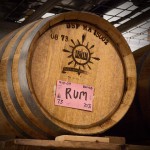 Kathy led a very historically informative tour, with lots of information about Prohibition, and how current regulations came about. For example, after Prohibition, the tax rate of spirits was determined by the amount it would take to pay the salaries of two federal revenue agents. This enabled the government the funds to hire the staff needed to regulate the industry. During Prohibition, there were far too few agents (about 1,500 for the entire country) to keep illegal spirits from being produced and distributed. Every distillery now has a government-bonded warehouse section designated for inventory. Once you remove a bottle from that bonded area, you owe excise tax on it. Currently, the excise tax sits around $2.90 per bottle; you basically have to pay the government their cut before you can sell your product. Taxes are due twice a month for the feds, and once a month for Taxachusetts.
Kathy led a very historically informative tour, with lots of information about Prohibition, and how current regulations came about. For example, after Prohibition, the tax rate of spirits was determined by the amount it would take to pay the salaries of two federal revenue agents. This enabled the government the funds to hire the staff needed to regulate the industry. During Prohibition, there were far too few agents (about 1,500 for the entire country) to keep illegal spirits from being produced and distributed. Every distillery now has a government-bonded warehouse section designated for inventory. Once you remove a bottle from that bonded area, you owe excise tax on it. Currently, the excise tax sits around $2.90 per bottle; you basically have to pay the government their cut before you can sell your product. Taxes are due twice a month for the feds, and once a month for Taxachusetts.
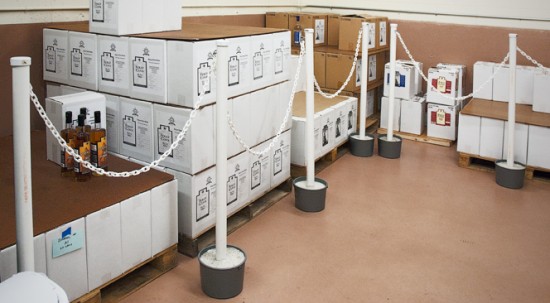
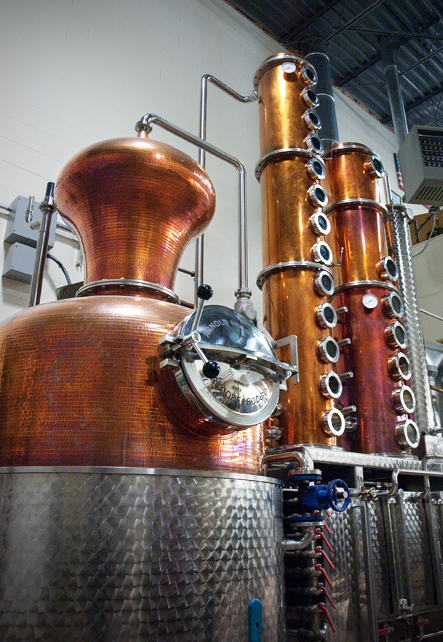 In the 1990s, the government lifted the two-agent tax structure, and put all of the reporting into the hands of the distilleries. They note their grain purchasing, production schedules, inventory, keep their own bonded warehouse sections, and report directly to the government instead of having agents check in. Another quirk of the system is that a new distillery may not apply for a federal license until the distillery is built. You have to purchase the stills, fermenters, whirlpools, etc and buy/lease a space all without the help of bank loans or investors, who won’t step in until you’re licensed. The government considers distilling equipment as a possible means to manufacture incendiaries (as in flammable liquids and/or bombs), and in the days of Homeland Security, they do a thorough background check. We’re talking three generations of your family for any felony crimes, and your bank records for any possible organized crime or terrorist connections. It took Ryan & Wood 11 months to get their equipment purchased, built, shipped and installed, starting in 2006. They were unable to even turn on the still until two years later when the licensing process was complete.
In the 1990s, the government lifted the two-agent tax structure, and put all of the reporting into the hands of the distilleries. They note their grain purchasing, production schedules, inventory, keep their own bonded warehouse sections, and report directly to the government instead of having agents check in. Another quirk of the system is that a new distillery may not apply for a federal license until the distillery is built. You have to purchase the stills, fermenters, whirlpools, etc and buy/lease a space all without the help of bank loans or investors, who won’t step in until you’re licensed. The government considers distilling equipment as a possible means to manufacture incendiaries (as in flammable liquids and/or bombs), and in the days of Homeland Security, they do a thorough background check. We’re talking three generations of your family for any felony crimes, and your bank records for any possible organized crime or terrorist connections. It took Ryan & Wood 11 months to get their equipment purchased, built, shipped and installed, starting in 2006. They were unable to even turn on the still until two years later when the licensing process was complete.
![]() When they finally got the still up and running, their first product was a rye whiskey, due to the two years needed for barrel aging. After its release, the rye was very well received, and during the aging a quirk of their barrel house was discovered: the casks that got some direct heat aged a lot quicker than those in the back of the room. Their current straight rye whiskey clocks in at 86 proof with a grain bill is approx 80% rye, 10% malted barley and 10% wheat.
When they finally got the still up and running, their first product was a rye whiskey, due to the two years needed for barrel aging. After its release, the rye was very well received, and during the aging a quirk of their barrel house was discovered: the casks that got some direct heat aged a lot quicker than those in the back of the room. Their current straight rye whiskey clocks in at 86 proof with a grain bill is approx 80% rye, 10% malted barley and 10% wheat.
Nose: Paint. Glue. Finally it hit me: PEAR. A pear aroma with alcohol behind it.
Taste: Pear again. Not sure where that flavor comes from, but that was the domineering trait I noticed. There’s an alcohol burn midway through, then a nice, rye snap.
![]() Next up was Folly Cove Rum, named for a popular local scuba diving and lobstering area filled with shipwrecks. Many much liquors came through Folly Cove during Prohibition, and Ryan & Wood’s product is a more traditional molasses-based rum. Its aged in both new charred oak and used Jack Daniels casks, then blended for color and flavor. It spends 15-18 months in the barrels, and is diluted down with Monadnock-sourced mineral water.
Next up was Folly Cove Rum, named for a popular local scuba diving and lobstering area filled with shipwrecks. Many much liquors came through Folly Cove during Prohibition, and Ryan & Wood’s product is a more traditional molasses-based rum. Its aged in both new charred oak and used Jack Daniels casks, then blended for color and flavor. It spends 15-18 months in the barrels, and is diluted down with Monadnock-sourced mineral water.
Nose: Creamy vanilla. Lots of cream. A little woodiness, with caramel.
Taste: Can taste the bourbon right up front, with a tasty, creamy mouthfeel.
![]() The Knockabout Gin is quite interesting. First of all, it’s named for a particular type of fishing schooner designed at the turn of the 20th century. The boats are distinctive for the lack of a wooden prow protruding from the bow. A topsail was added at the top of the mast eliminating the big bowspirit. Hence, the boats were able to bunch together in Gloucester Harbor and “knock-about” with the waves. The gin is somewhat citrusy, and uses a proprietary method to attain both lemon and orange flavors. Other ingredients include nutmeg, licorice, cinnamon, and Asian cinnamon, which I didn’t know existed. The goal was to produce a lighter, more mixable spirit that would appeal to a wider audience. Since I’m not a big gin fan, I can appreciate that, and found it quite nice. The citrus especially helps lighten the botanicals.
The Knockabout Gin is quite interesting. First of all, it’s named for a particular type of fishing schooner designed at the turn of the 20th century. The boats are distinctive for the lack of a wooden prow protruding from the bow. A topsail was added at the top of the mast eliminating the big bowspirit. Hence, the boats were able to bunch together in Gloucester Harbor and “knock-about” with the waves. The gin is somewhat citrusy, and uses a proprietary method to attain both lemon and orange flavors. Other ingredients include nutmeg, licorice, cinnamon, and Asian cinnamon, which I didn’t know existed. The goal was to produce a lighter, more mixable spirit that would appeal to a wider audience. Since I’m not a big gin fan, I can appreciate that, and found it quite nice. The citrus especially helps lighten the botanicals.
Nose: Quite citrusy, with a bit of pine, but a sweetish aroma.
Taste: Citrus sweet, then juniper pine in the middle with an alcohol burn. Sweet and even. Very nice.
![]() Finally, there’s the Beauport Vodka. As with most of their products, it too takes its name from local sources. In this case, “Beauport,” meaning “beautiful port” was the original name for Gloucester Harbor, somewhere around the early 1600s. The vodka gets up to about 95% alcohol (190 proof) during the distilling process, though is diluted back down to a drinkable (and legal) 40%/80 proof. It takes the alcohol in the vodka about four weeks of sitting around to recombine with the water. By comparison, the gin takes six weeks, due to the botanical oils present. The vodka’s mash bill is composed of barley, wheat, and rye.
Finally, there’s the Beauport Vodka. As with most of their products, it too takes its name from local sources. In this case, “Beauport,” meaning “beautiful port” was the original name for Gloucester Harbor, somewhere around the early 1600s. The vodka gets up to about 95% alcohol (190 proof) during the distilling process, though is diluted back down to a drinkable (and legal) 40%/80 proof. It takes the alcohol in the vodka about four weeks of sitting around to recombine with the water. By comparison, the gin takes six weeks, due to the botanical oils present. The vodka’s mash bill is composed of barley, wheat, and rye.
Nose: Well, it’s vodka, so there wasn’t too much to smell, though this one had a slightly wet, almost grassy aroma, not a hot alcohol sting.
Taste: Nice. It’s got a slightly slippery mouthfeel. Smooth, easy-going, no complaints. Very nice.

 Actually, we did the tasting after the tour, but it was easier to combine the descriptions with the tasting notes. At Ryan & Wood, the tasting area/ retail store is on the ground floor, and the production area is downstairs. A lovely copper pot still and column sit shimmering in the florescent glow, along with various tanks and other paraphernalia. Notably, two horizontal fermentation tanks used to ferment the molasses mash for their rum resemble fishing boats, and are named Adventure and the Thomas E. Lannon (I don’t remember who that was named for). These tanks were dairy coolers in a previous life, but now make tasty tasty rum mash.
Actually, we did the tasting after the tour, but it was easier to combine the descriptions with the tasting notes. At Ryan & Wood, the tasting area/ retail store is on the ground floor, and the production area is downstairs. A lovely copper pot still and column sit shimmering in the florescent glow, along with various tanks and other paraphernalia. Notably, two horizontal fermentation tanks used to ferment the molasses mash for their rum resemble fishing boats, and are named Adventure and the Thomas E. Lannon (I don’t remember who that was named for). These tanks were dairy coolers in a previous life, but now make tasty tasty rum mash.
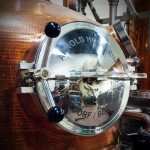 Ryan & Wood fall under the farmer-distiller license, as they only distill one batch at a time in their copper alembic still, as opposed to large commercial distilleries with continuous/Coffey/column stills. They mill their own grain, and distill “on the grain,” which means the wheat/barley/rye is not separated from the liquid in the wort, which some feel gives much more of the grain character and flavor to the spirit. Afterwards, the spent wort is sold as cattle feed, as is tradition among most brewers and distillers. The Lady Friend got to climb up and pitch yeast into one of the large, 1200 litre vertical fermentation tanks, which she was very excited about, squealing “I made liquor!”
Ryan & Wood fall under the farmer-distiller license, as they only distill one batch at a time in their copper alembic still, as opposed to large commercial distilleries with continuous/Coffey/column stills. They mill their own grain, and distill “on the grain,” which means the wheat/barley/rye is not separated from the liquid in the wort, which some feel gives much more of the grain character and flavor to the spirit. Afterwards, the spent wort is sold as cattle feed, as is tradition among most brewers and distillers. The Lady Friend got to climb up and pitch yeast into one of the large, 1200 litre vertical fermentation tanks, which she was very excited about, squealing “I made liquor!”
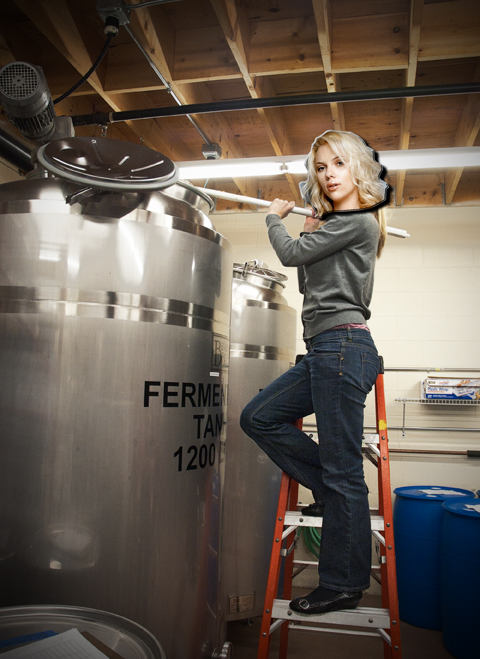

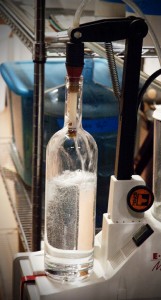
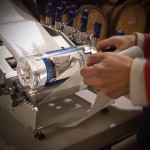 We continued over into second room filled with the barrel racks, where the rum and whiskies age. Towards the back of the room we took note of the “very secure warehouse” and got to see the bottling and labeling process. The bottles are filled from a somewhat jet-powered nozzle, then weighed to ensure the exact amount of spirit goes into each one. Too little or too much and the government gets cranky. The bottles are then corked, and fitted with a heat-shrink topper, which seals the cap, and counts as a tax stamp, since the bottle will now show signs of tampering. The labels are rolled onto the glass, and placed in a case (the vodka bottles have screened/painted labels). Repeat 12 times per case for hundreds and thousands of cases, and you’ve got a distillery. Well, after you distribute it as well, and Ryan & Wood is self-distributed. Those distribution contracts can set nightmarish quotas on small breweries and distilleries. The Lady Friend was again excited to give bottling, weighing, topping, and labeling a try, and did so with only minor financial damage to the inventory.
We continued over into second room filled with the barrel racks, where the rum and whiskies age. Towards the back of the room we took note of the “very secure warehouse” and got to see the bottling and labeling process. The bottles are filled from a somewhat jet-powered nozzle, then weighed to ensure the exact amount of spirit goes into each one. Too little or too much and the government gets cranky. The bottles are then corked, and fitted with a heat-shrink topper, which seals the cap, and counts as a tax stamp, since the bottle will now show signs of tampering. The labels are rolled onto the glass, and placed in a case (the vodka bottles have screened/painted labels). Repeat 12 times per case for hundreds and thousands of cases, and you’ve got a distillery. Well, after you distribute it as well, and Ryan & Wood is self-distributed. Those distribution contracts can set nightmarish quotas on small breweries and distilleries. The Lady Friend was again excited to give bottling, weighing, topping, and labeling a try, and did so with only minor financial damage to the inventory.
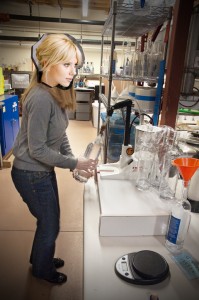
To end our tour, we headed back upstairs to sample the spirit lineup, which was very enjoyable, as most free booze is. Kathy and Bob could not have been nicer to us, (short of giving us a carload of free liquor) and the tour was incredibly informative. They’ll tell you just about anything you could possibly want to know about the process, since they were one of the earliest craft distilleries in the state, and had to go through all kinds of licensing and building nonsense. I have seen their products on the South Shore, in North Quincy’s Atlas Liquors, but if you can’t find it in your local packie, ask them to order some. The rye was a little odd for me, the rum quite nice, the vodka was… vodka, but a good one as vodkas go, and the gin was very lovely. Even though I’m not a gin fan, I’d say it was the highlight of the spirits. Contact Bob or Kathy on their website (it’s quite nicely designed), go for a tour and get some booze.
It killed off my cold*, and I can’t think of a better recommendation than that.
*WARNING! These statements have not been approved by the FDA, CDC, or CSI and may not be based in fact. SquirrelFarts is most likely making all this stuff up. But it cured his cold. Ryan & Wood make no claims that consumption of their products will prevent or cure any known disease. But it might. Go try some.